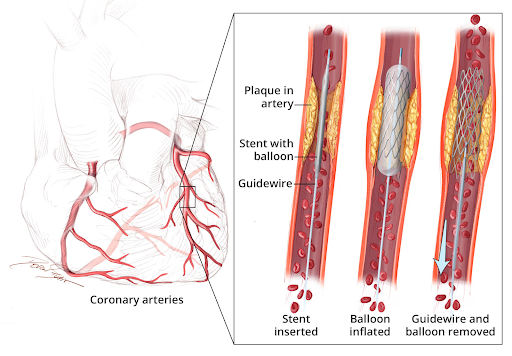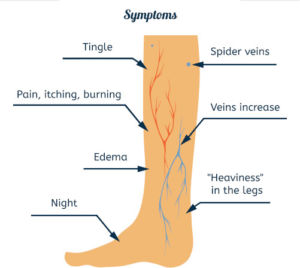Source link: https://www.ncbi.nlm.nih.gov/books/NBK499894/
Angioplasty, also known as percutaneous transluminal angioplasty (PTA) or balloon angioplasty, is a minimally invasive procedure used to open narrowed or blocked arteries, typically in the coronary arteries of the heart or the peripheral arteries in other parts of the body. It involves inflating a balloon-like device within the artery to widen the narrowed area and improve blood flow.
Procedure
During an angioplasty procedure, the patient is typically awake but sedated to help them relax. The procedure is performed in a specialized cardiac catheterization laboratory (cath lab) by a team of interventional cardiologists and nurses. The following steps outline the general process of angioplasty:
- Access: The cardiologist inserts a catheter (a thin, flexible tube) into a blood vessel, usually in the groin or wrist, using a small needle and guide wire. Local anesthetic is applied to numb the insertion site.
- Guidance: The catheter is advanced through the blood vessel and guided to the narrowed or blocked artery using X-ray imaging (fluoroscopy) and contrast dye injected through the catheter. This allows the cardiologist to visualize the location and severity of the blockage.
- Angioplasty: Once the catheter reaches the blocked artery, a deflated balloon attached to the tip of the catheter is positioned at the site of narrowing. The balloon is then inflated, pushing the plaque or blockage against the walls of the artery and widening the narrowed area to restore blood flow. The balloon is usually inflated multiple times to achieve optimal dilation.
- Stenting: In some cases, a stent (a small metal mesh tube) may be placed in the artery during angioplasty to help keep it open after the balloon is deflated. The stent is mounted on a balloon catheter and deployed at the site of the blockage. Once in place, the balloon is inflated, expanding the stent and pressing it against the artery wall. The balloon is then deflated and removed, leaving the stent in place to support the artery and maintain blood flow.
- Assessment: After the angioplasty and stenting are completed, the cardiologist assesses blood flow through the treated artery using angiography (X-ray imaging with contrast dye). This helps confirm that the blockage has been successfully treated and blood flow has been restored.
- Closure: After the procedure is complete, the catheter is removed, and pressure is applied to the insertion site to prevent bleeding. A bandage or closure device may be used to seal the puncture site.
Uses of Angioplasty
Angioplasty is used for various diagnostic and interventional purposes, including:
- Treating Coronary Artery Disease (CAD): Angioplasty is used to open narrowed or blocked coronary arteries in patients with CAD, relieving symptoms such as chest pain (angina) and reducing the risk of heart attack.
- Treating Peripheral Artery Disease (PAD): Angioplasty is used to open narrowed or blocked arteries in the legs, arms, kidneys, or other parts of the body affected by PAD, improving blood flow and relieving symptoms such as leg pain or numbness.
- Treating Acute Coronary Syndromes: Angioplasty is used as an emergency treatment for acute coronary syndromes such as unstable angina or heart attack (myocardial infarction), restoring blood flow to the affected part of the heart and minimizing damage to the heart muscle.
Risks and Considerations
- In-Hospital Death: Around 1%
- Coronary Artery Complications:
- Types: Perforation, distal embolization, side branch occlusion, stent thrombosis
- Myocardial Ischemia and Infarction: Risk: Potentially requires urgent coronary artery bypass graft surgery in severe cases.
- Vascular Complications:
- Types: Access site bleeding, retroperitoneal bleeding, atheroembolism. Rarely, angioplasty can cause injury to blood vessels, leading to bleeding, hematoma, or pseudoaneurysm formation
- Stroke: Rate: About 0.1% to 0.4% (one to four per thousand)
- Other Important Complications:
- Acute Kidney Injury: Often related to contrast nephropathy
- Anticoagulation-Associated Bleeding: Requires careful management of anticoagulation therapy to mitigate risk
- Allergic Reaction: Some patients may experience allergic reactions to the contrast dye used during the procedure, which can range from mild to severe.
- Restenosis: In some cases, the treated artery may narrow again (restenosis) after angioplasty, requiring repeat procedures or additional treatments to maintain blood flow.
Conclusion
Angioplasty is a valuable interventional procedure in cardiology, providing effective treatment for narrowed or blocked arteries in the heart and other parts of the body. When performed by experienced interventional cardiologists in specialized catheterization laboratories, angioplasty can help relieve symptoms, improve blood flow, and reduce the risk of complications in patients with coronary artery disease, peripheral artery disease, or acute coronary syndromes.




